Where to go in Switzerland on a short trip: Alps, lakes, and cities
Switzerland is an extremely popular country for those planning multi-stop tours around Europe, yet very few potential first-time visitors actually know specifically where they want to go. Everyone seems to know that it has the most beautiful views of the Alps and some very impressive cities, but there are actually many misconceptions among casual trip planners, so I’d like to clear most of that up below. The places to visit in Switzerland are not obvious until you’ve been there yourself or done many hours of research, so the list below should be a short cut.
I get hundreds if not thousands of itinerary questions for people who are considering a Eurail trip around Europe, and most people just include the word “Switzerland” among a list of cities like Paris, Rome, and Berlin that they want to visit. So where in Switzerland should you go if you can only make a few stops at most? I’ll answer that question below. You’ll mostly want to focus on the best choices for Swiss Alps trips, which I’ll go over below.
Note: This article was expanded and updated in February, 2024.
Switzerland is about outdoor views rather than city visits
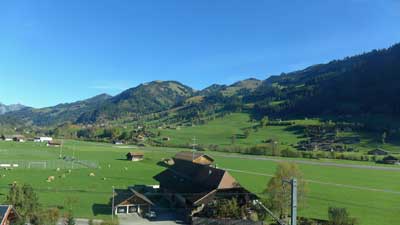
Geneva is a very famous city (though not for tourism reasons) on a lovely lake of the same name, but it’s also notoriously dull and lacking distinction. Rick Steves puts it well by saying that “Geneva is pleasantly situated on a lake, like Buffalo or Cleveland.” The point is, you don’t want to go to Geneva unless you’ve got something specific in mind that you want to see there. There are much better places to visit in Switzerland if your time is limited, or even if it’s not.
Switzerland's cities in summary
Zurich – The largest city, very expensive, geared towards business travelers. It’s generally a pretty and very well-run city that you would enjoy if you visited, but it’s not nearly as interesting as the likes of Vienna, Munich, or of course Paris.
Geneva – Second largest city, in the French part of the country, no major sights. Again, if you visited you’d be very impressed by it and get some great photos, but it’s not worth your time unless you know someone there. There’s an impressive fountain in the lake and you can usually see it from the train as you go through the city, but it’s not really worth going there and staying more than an hour or so.
Basel – Bordering France and Germany, no major sights. It has the famous art market each year, and aside from that it’s even duller than the ones above. Again, if you visited you’d be impressed, but if you later compared photos with friends who went to the Lauterbrunnen Valley instead, you’d kick yourself for going to Basel.
Lausanne – Near Geneva in the French part of the country, very hilly, and certainly more interesting than Geneva.
Bern – The capital, compact, on a lovely river, some interesting sights and the best Swiss city to get a feel for the culture. Bern is fairly close to Interlaken (which we will discuss below) and it can be a great day trip from there, especially on a day where it is foggy and/or rainy in the mountains (and this happens a LOT).
How much time and which Swiss cities to visit?
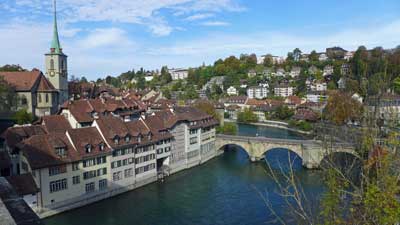
Many people (me included) don’t feel as if they’ve scratched the surface of a new country if they haven’t spent at least a day or two in the largest city. Zurich is certainly pleasant and a useful transit hub so spending one or two nights there wouldn’t be a major mistake. But Zurich isn’t even close to being a city like Paris, Rome, Berlin, Amsterdam, or even Vienna. If you skip it in favor of spending more time in the Swiss Alps, you won’t be missing much.
The 2 Best places to visit in Switzerland for short visits
Interlaken – If you want the best possible Alpine views and activities, head to the Interlaken area, which will be described in detail below. This is my favorite of all places to visit in Switzerland and it will probably be yours as well.
Lucerne – The traditional Swiss tourist retreat, Lucerne is a small city with interesting culture and sights, that is gorgeously set on a lake with plenty of top activities surrounding it.
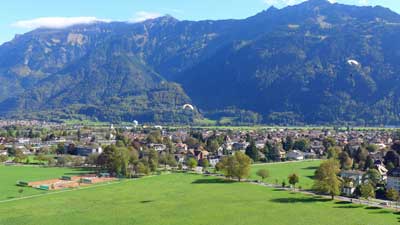
>>>Interlaken and Lucerne: Which to choose and how long to stay in each?
The article linked above will give you more details on which to choose and how long to spend in each place.
What about Zermatt for Alpine views?
Zermatt is a remote car-free village in southern Switzerland that is famous for being the place to see the Matterhorn mountain. It’s also a busy ski resort area, and aside from that, there isn’t much to see or do here. It’s on a private rail line, so it’s more complicated and usually more expensive to reach than Interlaken.
In other words, unless you’ve irrationally placed “Seeing the Matterhorn in person” on your so-called bucket list, skip Zermatt and head to Interlaken on a shorter visit. You won’t be sorry. If you already have enough time in your visit for the main sights around Interlaken and Lucerne and you want to also see the Matterhorn, then by all means go and you’ll enjoy it. There are quite a few other car-free villages in the Lauterbrunnen Valley near Interlaken, so they are not as novel in Switzerland as one might expect.
A weekend in Switzerland? What to see in 3 days
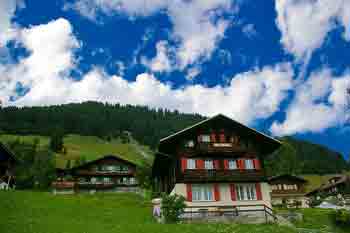
One challenge is that neither has an international airport so you’ll either be flying into Zurich or perhaps Geneva.
Train times from Zurich to Lucerne to Interlaken and back
- Zurich Airport to Lucerne: 1 hour 10 minutes by train
- Lucerne to Interlaken: 2 hours by train
- Interlaken to Zurich Airport: 2 hours 15 minutes by train
As you can see with the travel times above, Zurich Airport to Lucerne is a fairly short trip, but once you add Interlaken into the mix (even if you skip Lucerne) the travel time starts to add up for a weekend visit. With this in mind it’s probably best to just choose one of them and save the other one for another trip.
Lucerne is gorgeous, but the Lauterbrunnen Valley near Interlaken is really the star of the show, so I’d recommend going there first and doing Lucerne on another trip.
What about the Swiss Travel Pass?

The bottom line is that if you are coming to Switzerland for at least 3 days and you want to take 2 or more of the amazing scenic rail journeys that the country is famous for, the travel pass is probably a good deal. It also provides 50% discounts on the Schilthorn cable car and 25% off the Jungfraujoch mountain railway. Both of those are quite expensive on their own, but extremely worthwhile, so the discount is helpful.
The Half Fare Card is probably a better deal for most people
The Swiss Travel Pass is a good deal for those who are going to be spending at least 2 or 3 days riding the rails and seeing Switzerland that way. But if you are mostly going to be focusing on Interlaken and Lucerne and the mountain sights, the Half Fare Card is the best option. For CHF120 (about US$134) you get the card that is good for 30 days and gives you a 50% discount on all trains, cable cars, mountain railways, and other sights and attractions. If you are doing either Schilthorn or Jungfraujoch, the Half Fare Card practically pays for itself with just one of those.
>>>Buy the Swiss Half Fare Card
Many people have questions about the Swiss Half Fare Card so I will explain it a bit here. You can actually buy half price train tickets for travel within Switzerland any time you want and you will see that option when you go to buy them online. The only thing is you have to have and present a valid Half Fare Card when you get on the train and are asked to see your ticket. In other words, you can buy a half fare train ticket today and buy a Half Fare Card just before you get on that train months in the future, and you are fine.
How and why visit the area around Interlaken
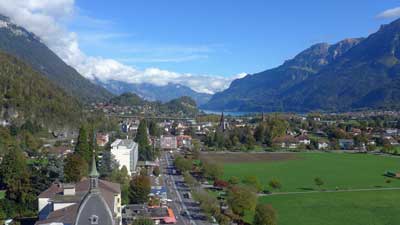
You can see everything discussed below by actually staying in a hotel in Interlaken, but it’s not the Alpine experience that you get if you stay in one of the small villages nearby. You can reach those villages in 20 to 40 minutes from the Interlaken Ost (East) train station, and it’s much easier than it sounds.
The 3 best places to stay to visit the Swiss Alps
Lauterbrunnen – A private train line runs from Interlaken Ost station to the end of its line in Lauterbrunnen. There’s a lovely waterfall here and great hiking trails, but you should probably only stay here if you can’t get to one of the villages mentioned just below. It’s a great little transit hub and it’s definitely gorgeous, so it can be worth a night if you’ve got one to spare.
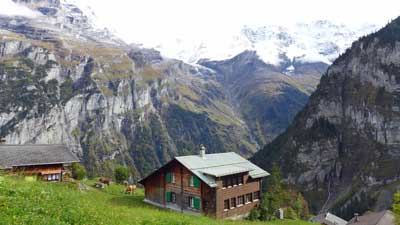
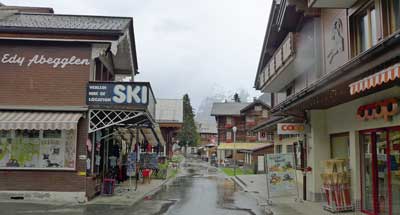
Where to stay in Interlaken and the Lauterbrunnen Valley (with pics)
I get so many questions about where to stay in the Interlaken area that I decided to write a longer version of it and load it with huge photos so readers can get a better feel for each option. I also included recommendations for affordable and well-located photos in each area.
>>>Where to stay in Interlaken and the Lauterbrunnen Valley New for 2024!
The unforgettable things to see here (if the weather is decent)
Schilthorn observation deck and restaurant
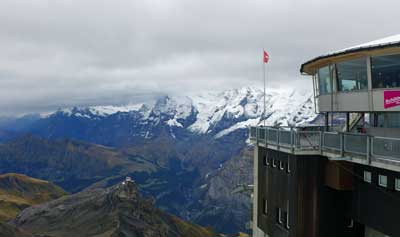
There is a rotating restaurant (with prices similar to normal Swiss restaurants) and a bizarre and anachronistic James Bond attraction based on it being a key location in the 1969 movie On Her Majesty’s Secret Service. The Bond thing is included with the lift, and it’s worth a look.
But the main thing you come here for is the 360-degree view from one of the highest peaks in Europe. Again, the weather here is key, but fortunately all the locals track the visibility on a minute-by-minute basis. If it’s clear up top while you are in the area, it would be a terrible shame to skip it based on the high price. But even if it’s cloudy up top, there are still plenty of wonderful things to see and do in the villages below.
Jungfraujoch observation area
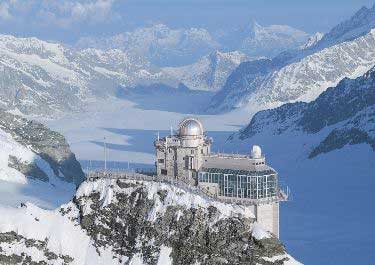
The views from the top are similar to the views from Schilthorn, from the other side of the Lauterbrunnen Valley. Once on top you can have lunch, hike, or even go sledding. It’s also quite expensive at nearly US$200 round-trip unless you have a Swiss Pass or a Eurail Pass for discounts, and it takes most of your day, but you’ll never forget the views from the top.
Harder Kulm mountain and Two Lakes Bridge Observation Deck
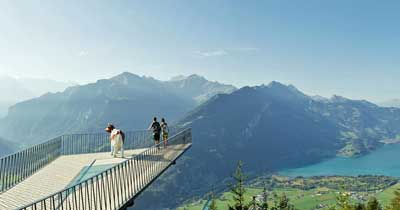
There’s a revolving restaurant about 10 minutes’ walk from the station at the top, which is definitely an unforgettable place for lunch if you’ve got time. It’s not as expensive as you might expect, at least compared to normal restaurants in Switzerland.
The Harder Kulm Railway goes from early April through late November each year. If you are only in Interlaken for one day and/or you are on a strict budget, this is the fastest and best way to get amazing Alpine views in the area.
Getting from Interlaken to Gimmelwald and Mürren
Getting up to these villages sounds complicated and time consuming, but it’s actually fast and easy once you get there. This little guide should help.
Arrive in Interlaken
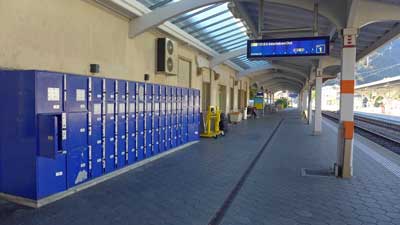
Once you arrive at the Interlaken Ost train station, head for the ticket windows in the office and buy a ticket to your final destination (Lauterbrunnen, Gimmelwald, or Mürren). Eurail passes are good for 25% discounts on the rest of the trip, but not for the whole thing.
From Interlaken Ost to Lauterbrunnen
The private train leaves Interlaken Ost every 30 minutes and arrives in Lauterbrunnen 20 minutes later. If you are staying in Lauterbrunnen then you are probably walking distance from your hotel when you reach the station.
From Lauterbrunnen to Gimmelwald
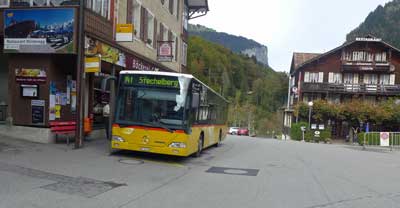

From
Gimmelwald to Mürren
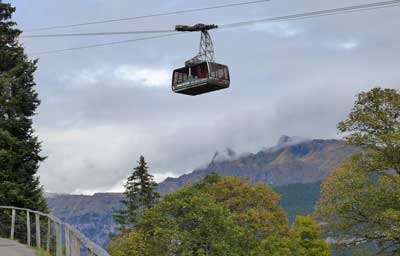
Recommended hotel and hostel in Gimmelwald
I get asked all the time about where to stay in Gimmelwald, so here it is:
Hotel: Esther’s Guesthouse
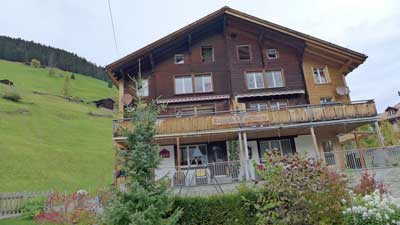
It’s run by Esther, as you might guess, and she is very friendly speaking excellent English. Each room is different and the place feels like a mountain cabin, because it is. She offers an excellent buffet breakfast in the morning, which you have to order the night before. It’s not cheap, but it’s worth it because it’s hearty and there are no other good options nearby.
Book as early as possible because this place is often the first place to sell out in Gimmelwald.
Hostel: Mountain Hostel Gimmelwald
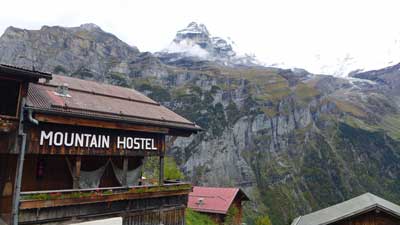
You won’t believe the views from this place, which are the same as from Esther’s except a bit lower and more unobstructed. This place also has a busy bar and restaurant that is basically the only “nightlife” in Gimmelwald. Many hikers get to bed early in this tiny village, but if you want to have a couple drinks and order a pizza or some local options, this is the place to go.
Again, book early because this place is always sold out.
Lucerne and what to do there
Luzern, as it’s spelled locally, is the other traditional holiday destination in Switzerland. Unlike Interlaken, Lucerne actually qualifies as a small city rather than a small resort town, so it’s a very nice contrast and very worthwhile. We have a new article with advice on where to stay in Lucerne and it should be helpful.
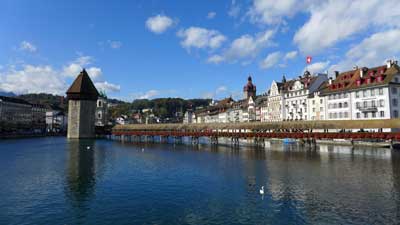
However, unlike Interlaken, the town of Lucerne itself is a great attraction and worth at least a day of exploration. This has always been a rich area so you can expect to find all of the high-end shops and boutiques along the small streets just north of the lake, but there are also many traditional shops and things to see that will appeal to anyone.
Recommended hotel in Lucerne
>>Hotel Des Alpes (3 stars with an amazing location and view)

If this place is booked, which is often the case, then book a hotel as close to it as you can find or afford. The whole historic part of town surrounding it is lovely, with restaurants, bars, and high-end shops. There are also a couple of nearby supermarkets where you can buy inexpensive alcohol and picnic supplies to keep other costs down.
Spend a day in Lucerne itself
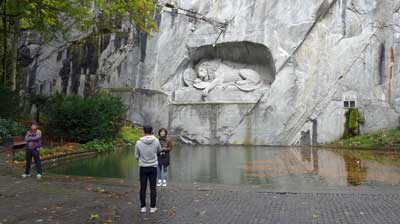
Most of the interesting part of Lucerne is in the area behind those restaurants, and it’s certainly worth doing a self-guided walking tour if not a guided one. Heading farther east you’ll come to another older part of town where the famous lion statue is located. You can’t visit Lucerne without having a look at the lion, and fortunately it’s easy and quick to reach (and it’s free).
Take a lake cruise of some kind
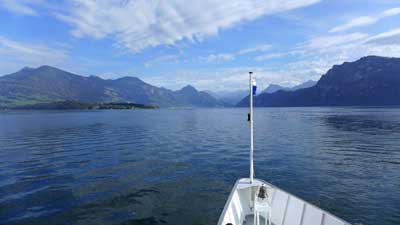
Especially in nice weather, even the short lake tour is lovely, and if you have more time you can jump off at Vitznau and do the scenic hike up Mount Rigi. There are also small lakeside villages that are ideal for a stroll and lunch stop. Long story short, there are dozens of interesting sightseeing options that are available using part of the boat tour, and the views all around are wonderful.
Visit Mount Pilatus
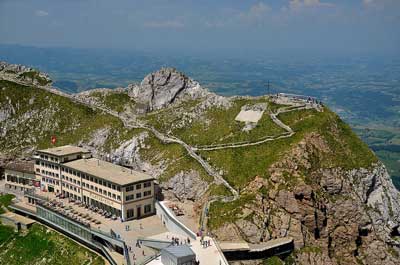
You can take the cogwheel train up and have a more or less flat hike around the summit area, and then take the gondola and cable car back down again. You can do them in the other order, and the cost is the same either way. At around US$65, this is not a cheap hike, but like most everything in Switzerland, the quality is high so it doesn’t feel like a rip-off. You can reach the cable car in 10 minutes on a public trolly bus from Lucerne.
Visit Mount Rigi
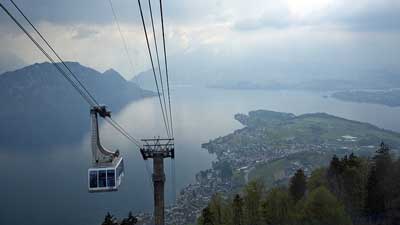
Unlike the other peaks mentioned in this article the Swiss Travel Pass covers both ways to get up and down for free. The others are 50% off with the Swiss Travel Pass or Half Fare Card, except for Jungfraujoch, which is only 25% off with the Swiss Travel Pass and still 50% off with the Half Fare Card.
Visit Mount Titlis
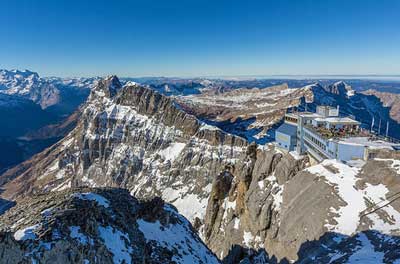
You can reach Titlis by taking a 43-minute train ride from Lucerne to Engelburg and then taking the cable car up from there. As with the others, it’s wise to check the weather immediately before you are going to depart because it can be foggy or cloudy any time of the year, but usually not for whole days at a time.
Additional photo credits
Jungfraujoch by cupweuro on Flickr, Pilatus by Tony Fernandez on Flickr, Rigi by Kosala Bandara on Flickr, Titlis by PaulSchliebs on Flickr

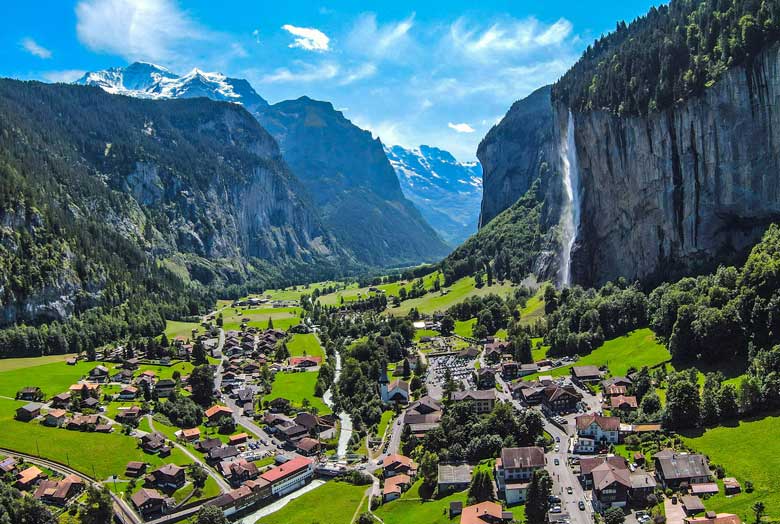
Thanks a lot for your detailed and quick response.
Just got a query about Golden Pass express. I read below in tripadvisor dated Sep 2013 however just want to clarify with you about the current process.
——————–
– Reservation is recommended if you want the ‘VIP Seats’ – seats in the front of the train in 1st Class. Basically you would sit in the train driver’s position with a panoromic view. The drivers position is moved up one level.
– If you have a 2nd Class Swiss pass and want to reserve the VIP Seats, first reserve your seats paying the reservation fee. Then before commencing your journey you can pay the difference between 1st and 2nd Class for the sector you are travelling to upgrade. This can be done at the SBB ticket office or even on the earlier train with the ticket checker.
——————–
I am going to purchase 2nd class swiss travel pass. Even after reservation do i still need to pay the difference between 1st and 2nd Class for my journey between Luzern to Interlaken?. Is it the same procedure for Glacier / Gothard express as well (or) just seat reservation is sufficient ?
Tourist,
All of that information from the Tripadvisor post looks accurate to me. I do believe that the VIP seats are only in the 1st Class carriage, so in order to reserve one of those you would have to pay the difference. I think it’s the same situation on the other scenic trains, but I haven’t looked at all of them. It should tell you on the specific official web page for each route. Have a great trip. -Roger
Hello Roger Plenning a trip with my wife and two kids. never been to switzerland . traveling from the caribbean for 5 nights starting 6th July when we land in Paris and would like to celebrate my wife birthday which is on 7th in switzerland. landing in Paris and would like to take a train. need your recommendations on which parts to visit to maximize our experience. I am 49 years old my wife is 45 and kids are 18 and 12 both boys. would appreciate your advise. thanks
Max,
My best advice for this is in the article above. Especially on a first trip to Switzerland I would focus mostly on the Interlaken area for 3 days or so, and probably Lucerne for the other two days. Those two areas are quite different from each other and both are packed with top views and sights. With that in mind I think you’ll find the article above quite useful. Let me know if you have any other specific questions. -Roger
Hi Roger,
While googling to plan for a swiss trip luckily noticed this site and i am happy that i landed here.
Thanks a lot for your patience to answer everyones query.
Here is our trip plan for a family of 2. Let me know if it makes sense or anything need to be amended.
7th June – landing at basel airport @ 12PM – Travelling to lucerne and expected to arrive by 1:30 PM max – local sightseeing by walk- night stay @ lucerne
Decided to purchase only single journey ticket from Airport to Lucerne
Will purchase Swiss travel pass for following 4 days:
8th June -> Mt.Titlis – night stay at Lucerne
9th June -> Early morning travel from lucerne to interlaken via golden pass express – then go to jungfraujoch – Night stay @ Gimmelwald (or) Lauterbrunnen
10th sun -> If possible visit Schilthorn – on way back walk down from Mürren to gimmelwald – visit nearby villages – night stay @ interlaken
11th mon -> spend @ Interlaken till 11 AM – then catch Glacier express from Brig to Chur . Normal train from Chur – Basel and 12th morning 4AM return flight
Have below queries:
– As per your advise we are taking 2 panoromic trains (though not the full route). Just want to know purchasing swiss travel pass make sense in this case?
– Out of all the panaromic express, which route is most scenic and must watch based on that we can choose the express
– Is Mt.Titlis worth seeing (or) we can skip that and take Gothard Panaromic express (or) Bernina Express from Lugano – Chur on 8th June ?. In addition, how to identify Gothard Panaromic express in SBB site . I see many “Travel with” options like VAE, EXT 2892 ,BAV which is the correct 1 mapped to Gothard express.
– Say if we take Gothard express on 8th june and return to lucerne by 14:47 can we still make to Titlis (or) Pilatus (or) Rigi after that (or) it will be hectic ?
– Roughly how long it takes to visit Mt.Titlis and Jungfraujoch.
Sorry for shooting more questions but we want to make the best use of our swiss travel pass hence asking.
Note : We 2 are avid travellers and travel a lot so want to cover as much as possible.
I know your reply will be a most constructive one which can make things crystal clear. Thanks again for helping us and everyone.
Forgot to mention 1 thing. This is my 1s visit to swiss and my partner’s 2nd visit.
Last time my partner visited Mt.Titlis, Jungfraujoch but never experienced panoramic trains so more keen about those.
Considering all this the above itinerary was drafted so it can do proper justice to our trip. Thanks again.
Tourist,
I’ll try to answer your question.
Yes, I think a Swiss Travel Pass should be great value for you on this trip, especially if you visit Schilthorn. If you stay in Gimmelwald then it takes a bit under an hour to get up to the top, and since it’s included you might as well.
I have taken many trains in Switzerland but the only “scenic” route I’ve taken all the way is the GoldenPass. The photos for all of them look fantastic, but the good news is that nearly every rail journey within Switzerland is extremely scenic. My theory is that they created those special trains with names to help guide people to some of the highlights, but if you just take normal trains between places in Switzerland that you want to visit, you’ll find them all incredibly scenic. If you have a Swiss Travel Pass I agree that it’s a good idea to take advantage of at least one scenic train in a panoramic carriage, and I’m sure you’d enjoy any of them. Just have a look at the photos on the official websites and figure out which one is the easiest to fit into your itinerary. Sorry I’m not more help on this.
Mt Titlis is another great peak in Switzerland, but really Jungfrau and Schilthorn are the most amazing so I would do the train ride. I’ve noticed that booking those panoramic carriages can be confusing, but I’ve also noticed that many if not all of those scenic trains has its own website where you can book the special departures and carriages. I haven’t done it myself so I am not much help on this, but hopefully you can figure it out.
If you return to Lucerne at 14:47 on that day you’ll be pretty worn out, but you still might be able to do Mt Rigi. You can walk out of the train station and straight ahead to the boat dock and you might even be able to get a 15:00 departure. Then I think it’s the first or second stop and you get off for the train or cable car up to Rigi. Since the sun sets so late that time of year, I think you’d have time to go up and down without having to rush much.
Visiting Mt Titlis from Lucerne usually takes about 6 hours, and Jungfraujoch from Interlaken takes about the same. However, if you start going up Jungfrau from Wengen or Grindelwald it cuts up to an hour off it because you are already part way up.
You are going to have an excellent time and it looks like you are hitting all of the top attractions plus a train ride or two. -Roger
Hi Roger, we need your help!
We will be travelling to Switzerland (free and easy) in end May, around 10 nights.
We will be arriving at Zurich (one night),
Follow, to Lucerne (2 nights),
From Lucerne-> Interlaken—— planning to take scenic train
Interlaken (1 night)
Interlaken to Murren (1 night)-> Schilthorn (spend 1/2 day exploring)-> back to Murren (1 night)-> Jungfraujoch-> Grindelward (1 night) -> Interlaken
Then, once return to Interlaken-> Zurich (1 night)
Qns:
1) Swiss travel pass will be the best choice right?
2) Can we use swiss pass when travelling around Zurich, Lucerne, Interlaken if using bus or train? Or hotel will provide transportation card for us?
3) If taking cable cars around Jungfrau region, do we have to book beforehand? And can we use Swiss pass?
4) only 1 scenic train from Lucerne to Interlaken. Any other scenic train we can take from our itinerary?
5) MOST IMPORTANT!
Is it possible to keep our luggages in Interlaken train station locker for around 4 days and take a small bag and explore around Jungfrau region? Afraid will be troublesome to drag our luggages and take cable cars.
Thank you very much for your help! Greatly appreciated!
Mins,
I’ll try to help.
1) Yes, for a long visit like that I think the Swiss Travel Pass will save you more than the Half Fare Card.
2) The Swiss Travel Pass isn’t valid on local transit systems, but you won’t actually need it for that anyway. The main part of Zurich is walkable and if you do need to take buses I’m sure they sell a day ticket for a small price. In Lucerne you will also want to walk most places and if you are staying so far away that you need a bus, you are in a remote neighborhood and should probably book somewhere more central. It’s a pretty compact city. The boat rides on the lake ARE included with the Swiss Travel Pass, and that is how you’ll get to nearby villages and the base of Mt. Rigi.
In Interlaken each hotel gives you a card for public transportation for the length of your stay. Most of the town is close to the Interlaken West train station, and the Interlaken Ost (east) train station is the main travel hub for trains into the Lauterbrunnen Valley where Schilthorn and Jungfraujoch are located. With the transit card you can take trains between the stations for free, and since all trains stop in both stations I’m pretty sure they never check tickets in the few minutes it takes between them. The Swiss Travel Pass DOES cover most things going up into the mountains in the Lauterbrunnen Valley, although it only gives a 25% discount on Jungfraujoch from the last station up to the top and back.
3) You don’t have to pre-book cable cars and the Swiss Pass DOES cover all of them now, I think, including all the way up to Schilthorn. They operate kind of like buses. For example, the one going up to Schilthorn holds about 80 people (all standing up) and it leaves every 30 minutes.
4) The train ride between Lucerne and Interlaken is very scenic, but it doesn’t compare to the trains and cable cars you’ll take in the Lauterbrunnen Valley. Honestly, all of Switzerland is gorgeous, except for the large area right around Zurich, and even that is pretty nice.
5) There ARE luggage lockers at the Interlaken train stations, but I’m not sure if there is a maximum time limit. I kind of assume there would be a maximum time because they don’t want people using them all up, and I think it would be expensive as well. They might also have a “left luggage” desk, and that might be a better option if they have one because those are operated by humans and arent’ meant for very short stays. Another option would be to find a hotel very close to one of the train stations and ask if they would look after your bags for a reasonable fee. That is my best suggestion and I hope you figure it out. -Roger
Hi Roger,
Great Articles about swiss tour…
I am Muhammad Rizwan from Pakistan and I will be traveling to Swiss in June 16-19, 2018.This is my first time to Swiss so I need your guidance to plan my trip.
Actually I will be travelling to Milan Italy for an official meeting and then after spending 2 days in Italy I will move to Swiss on June 16, 2018.
So I want to make most of these 3 days.
So Please guide me for the following.
1) Best places to visit in swiss
2) Mode of travel
3) Which hotel is good
4) Availability of halal food
I will fly back from Zurich so please guide.
Kindly guide us what we have planned is good or not.
I like to watch , visit mountains naturally beauty of swiss.
Thanks you
Muhammad R. Tariq
Muhammad,
I’ll be happy to try to help.
1) Actually, the whole article above is meant to be the answer to this question. The short answer is that Interlaken is the most dramatic place to visit and if you have enough time you might also go to Lucerne for a day or so.
2) The trains in Switzerland are probably the best in the world. You’l probably want to buy a Half Fare Card for CHF120 because the normal fares are quite expensive and it’s easy to save enough money in even two days of sightseeing and riding on trains. It’s explained more on the article about the Swiss Travel Pass.
3) I also mention some hotels in the article above. I prefer not to make specific recommendations aside from those because room rates and budgets and availability can vary. For the most part, hotels in Switzerland are quite expensive, but you tend to get what you pay for. In other words, if one hotel charges double the hotel next door, it’s probably MUCH nicer.
4) I’m not so sure about halal food but I suspect that you won’t have problems. Switzerland is extremely popular with Indians and therefore there are many Indian restaurants and most other restaurants have several good vegetarian options. There are also quite a few Muslims traveling around Europe and Switzerland is a very open and accepting country so I’d suspect that you’ll have good options, at least in the most popular places such as Interlaken and Lucerne.
I wouldn’t even visit the city of Zurich because you can take a train directly to Zurich Airport without having to change trains in the city, and trains run from very early until late in the evening. Focus on the Interlaken part of the article above and that is probably your best option if you only have 3 days. The Alpine scenery there is amazing. -Roger
Hi,
Thank’s for this very informative blog. I and my husband are travelling to Europe in july for 14 days. From 16th july to 30th july.
I have planned to travel 4 countries, UK, Paris, Switzerland and Italy. I have planned 3 days for UK, 3 days for Paris, 4 days for Switzerland and 4 days for Italy(Florence, Venice and Rome). My plan is as follows:
16th July: Morning flight from Mumbai to London. I have decided hotel which is 15 min walk from London Bridge. So after reaching to hotel will visit London bridge at night.
17th July: Will visit Tower of London in morning and then in evening visit to millenium bridge and london eye with river cruise.
18th july: Visit to Madame Tussauds museum in morning and then Buckingham Palace and hyde park in evening.
19th july: Visit remaining sights in london. Westminster Abbey, trafalgar square, big ben, whitehall etc and in evening a eurostar train from london to paris, europe.
20th july: Louvre museum in mornig and Notre Dame Cathedral in evening.
21st july: champs Elysées / Arc of Triumph in morning and Eiffel Tower in evening with a seine river cruise.
22nd july: Disneyland
want to visit The Latin Quarter – Luxembourg park, but i thing I will not get time in above plane
22nd evening will go to Switzerland from paris by train. Plan is Switzerland is not yet finalized.I am just thinking to spend 2 days in interlaken and 2 days in lucern. and will cover most of activities like cable car mountain top etc. So i think will take 3 days or days swiss pass.
23rd to 26th july in Switzerland(Interlaken and Lucern)
27th to 30th in Italy- Rome Venice and Florence
Now my doubt or question are:
1.I have just 4 days for Italy to travel 3 long distance cities and have to fly back. So should I go with above plan or should I skip Italy and explore Switzerland more like to add 1 day trip to zurich from lucern and 1 day trip to bern from interlaken and 1 day trip to black forest and Rhine fall trip?
2. Should I go to Disneyland in Paris?
3. I am skipping Latin Quarter – Luxembourg park in Paris, is that ok or I should cover it.
thank you in Advance,
Supriya
Supriya,
The shortest Italy trip that I recommend is 6 days, which is 1 day in Venice, 2 days in Florence, and 3 days in Rome. In 4 days I would suggest 1 day in Venice and then 3 days in Rome, but it might make more sense to save it for a future trip. I wouldn’t visit Zurich unless there is something specific there that you want to see, mostly because the Alps and scenery all over the country are amazing and the cities aren’t very special. I’d probably use those extra days to add one to London, Paris, and Switzerland instead. Going really fast through Italy will be tiring and probably not worth it. The Black Forest doesn’t have much to see either, but Rhine Falls is a good day trip from what I’ve heard. I’d stay in Switzerland rather than going into Germany.
As for Disneyland, many people love it so it’s a personal choice. I grew up about 15 minutes drive from the original Disneyland in Anaheim so I wouldn’t go to the Paris one unless I had a kid who really wanted to visit it with me. But again, it’s very popular and if this is your first Disney visit you’d probably love it.
Even if you didn’t add a day to Paris I think you’d have time for a stroll through the Latin Quarter and Luxembourg Park. When you visit Notre Dame you can just walk across the bridge and you are in the Latin Quarter. You can walk a few blocks and you are already close to the park. However, there are many other interesting neighborhoods in Paris and quite a few other parks as well. I personally really like the Montmartre neighborhood in the evening because it’s lit up so beautifully as you are walking down the hill from the Sacré-Cœur cathedral. Let me know if you have any other questions. -Roger
Wow, Roger, I have read through your epic site and taken some great notes, but I didn’t see much about the northeastern part of Switzerland. End of May, I will be visiting my son who is studying for the semester in Augsburg, Germany. We have a free apartment to use in Davos for a weekend so we are renting a car in Munich and driving to Davos (3 hrs) with a stop in Fussen to see the castle. After reading your wonderful posts, I’m now wondering if we should only stay in Davos one night and then head to Interlaken for a night and then up to Lake Constance and back to Munich. But , lots of driving for three days and as you have said, I would like to just stay put for 2 nights somewhere and hike and take in nature rather than sit in a car! I just haven’t found anything compelling in the Davos area, though the drive from Davos to luzern or Interlaken looks amazing. Any recommendations would be greatly appreciated thank you!
Susanne,
I’m always happy to hear that people find this useful. I haven’t been to Davos, although it looks lovely on TV and that whole area is quite scenic, it appears. I’ve been to Appenzell, which is a gorgeous little town surrounded by famous dairy pastures, and it might be worth a look. It’s a tough call. I’m confident that if you stayed in Davos you’d find it to be amazing and you wouldn’t get bored. On the other hand, the Alps views around Interlaken are on another level and if you have time to spend a day there I think you’d be extremely happy with that decision as well. Have you thought about taking trains instead? They go everywhere you want to go and are famously punctual as well as comfortable. Driving 7 or 8 hours in a day can be exhausting even with great scenery, while doing the same trip on a comfortable train seat is relaxing.
I’ve mostly taken trains in Switzerland but my brother lives near Basel and I’ve ridden around with him a fair bit. The highways in Switzerland are all in great shape (it’s a rich country) and traffic should not be a major problem unless you are going in or out of Zurich or Geneva in the morning or late afternoon. I’m not sure if this is helpful at all, but I really do think you’ll enjoy whichever option you choose. I’m happy to answer other questions if you have them. -Roger
Hi Roger,
First of all…..really appreciate this blog and your zest to help so much.
Me and my wife are based in Dubai and have planned our trip to Europe this August (14 nights).
Arrival Rome on 18th Aug, 11am and Departure from Paris on 1st Sep, 6pm.
Though it’s our first trip to Europe together, she has been to UK couple of times and I’ve had a short visit to Paris once.
Suggestions on your various blogs has helped me draw the following itinerary:
Rome (3 nights), Florence-Pisa (2 nights), Venice (1 night), Zurich-Interlaken-Lucerne (3 nights), Amsterdam (2 nights), Paris (3 nights)
Will do all intercity travels by rail/coach, except for flying to Amsterdam from Zurich.
We intend to freeze the detailed itinerary asap and make all applicable bookings (travel/sightseeing) well in advance to take advantage of early booking.
I have the following queries and request for your advice so as to finalize the detailed itinerary:
1. Would it be better to drop Amsterdam in this trip. Instead, add one additional night at Rome/Zurich/Paris.
2. Can you suggest detailed itinerary for Interlaken & Lucerne – places to visit, travel mode, hotel names (budget stay), travel pass, private rail, cable car, etc.
3. Which are the ‘must see’ places in – Rome, Florence and Amsterdam.
4. Can you suggest city wise list of visit places for which I should do online bookings in advance so as to avoid high costs later.
5. Both of us take vegetarian food only – any tips for our trip?
Vishv,
I’m so glad to hear that this information is helpful. I’ll try to answer your questions…
1. I’m a huge fan of Amsterdam, but two days there and then a flight out is barely enough time to see just a few things there, so I’d probably save it for a future trip and add a day to Florence and one to Paris.
2. All of my best advice for a short visit to Switzerland is in the article above. I’d do 2 nights in Interlaken and 1 night in Lucerne, or just 3 nights in Interlaken. I mention places to stay in both areas and most of the top attractions, so it’s a matter of what sounds good to you. Most likely a Half Fare Card will be your best value, and that is discussed in the article about the Swiss Travel Pass. Most likely a Half Fare Card will save you more than the full pass, but it depends on how many things you do.
3. You can get must-see information on travel guide websites and I prefer to help more with logistics. I like wikitravel.org and lonelyplanet.com, but actually in Europe I prefer the advice from ricksteves.com.
4. I’d book your hotels at least a month or more in advance for the best prices and selection. Most attractions and things to do when you are in the cities are the same price on the day, but in some cases you can save a bit booking online, or at least avoid a ticket queue. Book all of your train tickets a month or more in advance for the best fares. The trains within Switzerland are the same price no matter when you book, so you can book those later or buy when you are there.
5. You shouldn’t have a problem finding vegetarian foods in the cities you’ll be visiting. Switzerland in particular is very popular with Indians and there are many Indian and veg options in all of the tourist cities. In the other cities you might have to look around a bit, but once you do you should find abundant veg options. Some other parts of Europe are more meat-centric, but France, Italy, and Switzerland are not like that. -Roger
Thanks, Roger.
I’ll start looking online at train schedules and hotels. This was a huge help!!
Anne
Anne Herod says:
May 1, 2018 at 1:22 pm
Roger,
Thanks for the help but now I have a few more questions:) Is there a better train to take for scenery? I keep reading about the Bernina and the Glacier Express. Also, would the Swiss Travel Pass get us a better discount on some of the cable cars or lake tours? What about places to stay in both areas? I think we would be better off coming back to Milan the night before our flight.
Since we are less than an hour from Kerrville, could we come buy your lunch and “pick your brain”? I’m a little intimidated when I look at those rail sites!!! Do you do consultations in person or by phone?
Thanks,
Anne